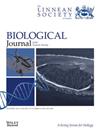日本源氏萤火虫的精细系统地理学
IF 1.5
3区 生物学
Q3 EVOLUTIONARY BIOLOGY
引用次数: 0
摘要
日本群岛由四个主要岛屿和许多小岛组成。后藤群岛位于九州附近,九州是日本群岛的一个主要岛屿。我们之前报道过,居住在后藤群岛的日本源氏萤火虫(Nipponoluciola cruciata)种群显示出一种独特的闪光模式,用于雄性和雌性之间的交配前交流,这表明后藤群岛种群可能与邻近的N. cruciata种群存在遗传隔离。本研究旨在通过细胞色素c氧化酶亚基II和ND5线粒体DNA区域的分子系统发育分析,以及核DNA单核苷酸多态性的全基因组分析,阐明后藤岛N. crucata种群与邻近岛屿种群之间的基因流动。结果表明,后藤岛十字花科植物种群与其他种群存在遗传隔离。基于核dna的种群分析表明,居住在九州岛和Iki岛的种群之间的基因流动,位于后藤岛和九州岛之间的距离大致相等。因此,后藤岛N. crucata种群的遗传隔离在很大程度上受到闪光模式行为的影响,强调了一个正在进行的物种形成过程。本文章由计算机程序翻译,如有差异,请以英文原文为准。
Fine-scale phylogeography of the Japanese Genji firefly
The Japanese Archipelago consists of four major islands and numerous small islands. The Goto Islands are located near Kyushu, a major island in the Japanese Archipelago. We have previously reported that the population of the Japanese Genji firefly, Nipponoluciola cruciata, inhabiting the Goto Islands displays a unique flashing pattern that is used for pre-mating communication between males and females, indicating the possibility of genetic isolation of the Goto Islands population from neighbouring N. cruciata populations. In this study, we aimed to elucidate the gene flow between the Goto Islands N. cruciata population and its neighbouring island populations by molecular phylogenetic analyses based on the mitochondrial DNA regions of cytochrome c oxidase subunit II and ND5, also coupled to genome-wide analysis of nuclear DNA single nucleotide polymorphisms. Our results suggested that the Goto Islands N. cruciata population is genetically isolated from other populations of this species. Nuclear DNA-based population analyses indicated gene flow between the populations inhabiting the Kyushu and Iki Islands, situated at a distance approximately equal to that between the Goto and Kyushu Islands. Therefore, the genetic isolation of the Goto Islands N. cruciata population is largely affected by flashing pattern behaviour, underlining an ongoing speciation process.
求助全文
通过发布文献求助,成功后即可免费获取论文全文。
去求助
来源期刊
CiteScore
4.30
自引率
10.50%
发文量
140
审稿时长
3-6 weeks
期刊介绍:
The Biological Journal of the Linnean Society is a direct descendant of the oldest biological journal in the world, which published the epoch-making papers on evolution by Darwin and Wallace. The Journal specializes in evolution in the broadest sense and covers all taxonomic groups in all five kingdoms. It covers all the methods used to study evolution, whether whole-organism or molecular, practical or theoretical.d.

 求助内容:
求助内容: 应助结果提醒方式:
应助结果提醒方式:


